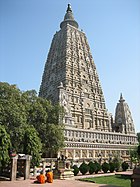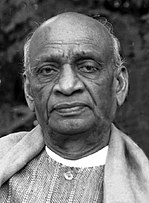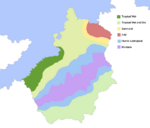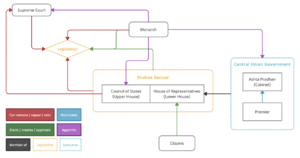User:Geordinia/sandbox13
This article is incomplete because it is pending further input from participants, or it is a work-in-progress by one author. Please comment on this article's talk page to share your input, comments and questions. Note: To contribute to this article, you may need to seek help from the author(s) of this page. |
Kingdom of Rajyaghar राजांचे साम्राज्य | |
|---|---|
| Motto: "Jai Maharaja" | |
| Anthem: "Kramākramānē" Step by Step (Estmerish) | |
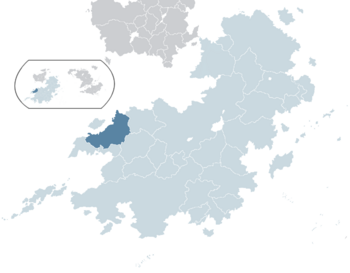 Location of Rajyaghar (in navy), within Coius (light blue) | |
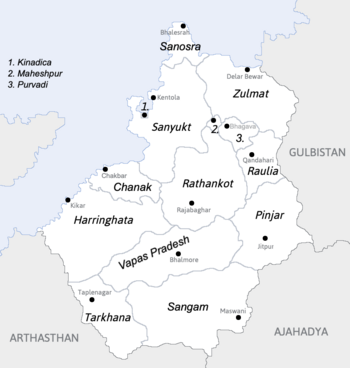 | |
| Capital | Kinadica |
| Largest Metro | Kakeki |
| Official languages | Matrabashi |
| Recognised regional languages | Zubadi, Bhasdila, !Sindhi, Vijayan |
| Ethnic groups |
|
| Religion | Ashankism (unofficial) |
| Demonym(s) | Rajyani |
| Government | Federal, Parliamentary, Constitutional Monarchy |
• Maharaja | Krishan VII |
• Crown Prince | Prince Akash |
• Premier | Madhava Thakur |
• Chief Justice | Vishnu Kapadia |
| Legislature | Shahee Sansad |
| Council of States | |
| House of Representatives | |
| Significant events & Formation | |
• Fall of the Rajana Dynasty | 815 CE |
• Creation of Satria Etruriana | 1847 CE |
• Independence from Etruria | 1946 CE |
| Area | |
• Total | 833,423 km2 (321,786 sq mi) |
• Water (%) | 2.5 |
| Population | |
• 2019 estimate | 84,267,147 (11) |
• Density | 101.1/km2 (261.8/sq mi) |
| GDP (PPP) | estimate |
• Total | 3 trillion |
• Per capita | $35,637 |
| GDP (nominal) | estimate |
• Total | 1.2 trillion |
• Per capita | $14,255 |
| Gini (2019) | 42 medium |
| HDI (2019) | medium |
| Currency | Rajyani rupee (RAR) |
| Time zone | UTC-2 (UTC) |
| Date format | dd/mm/yyyy |
| Driving side | left |
| Calling code | +52 |
| Internet TLD | .ra |
Rajyaghar (Matrabashi: राजांचे), officially the Kingdom of Rajyaghar (Matrabashi: राजांचे साम्राज्य), is a country in the Satrian region of the continent of Coius. Bound by the Acheloian Sea on the East, Rajyaghar shares land borders with Gulbistan to the east; Ajahadya to the south-east; and Arthasthan to the south-west.
Humans are thought to have arrived in Rajyaghar over 60,000 years ago with them being predominantly 'hunter-gatherers' which in turn has made the population of the land incredibly diverse. Settlements first began to emerge along the northern coastline and surrounding the Naratha River around 4,000 years ago, slowly evolving into the Ancient Rajyani Civilisations and then into the Naratha River Civilisation by 250 CE. Around this time was when the Ashankic faith began to emerge as well as a shared language and the clan system. Coalescence of communities and early political power gains around the Naratha River Basin resulted in the rise of the Jhanda Empire in the 3rd Century. The Jhanda Empire's lifespan would see the increasing status of women, development of a basic structure to society and a political framework that would last for centuries to come. The Empire would go onto conquer much of what is northern and coastal Rajyaghar until its subjugation in the 9th Century to the Sangma.
Throughout the Vikasan Era, the Ashankic faith would continue to dominate the region. The cultural integrity of the region was threatened numerous times during this period, ranging from the irfanic sultanates from the north-east to the Togoti Khaganate from the east. Gaullica and Etruria's arrival in the 19th Century would mark the end of domestic rule and the ushering in of the colonial era. In 1842, Etrurian Crown Rule began and the economy of Rajyaghar was transformed as the middle kingdoms were united into euclean colonies. Over time, Etruria, and Gaullica in the XX Peninsula, would introduce technological, educational and societal changes to Rajyaghar, some of which would be continued post-independence. By the time of the Great War, independence movements had begun to emerge, which was noted for its cooperative attitude which became a major factor in securing greater autonomy until the Solarian War in which the independence movement took up arms. In 1946 at the conclusion of the Solarian War, Rajyaghar became an independent, sovereign realm.
Rajyaghar is a fast-growing economy with a rapidly expanding information and technology sector which has moved the economy from being focused on agriculture to an increasingly diverse economy. With these changes, the country has seen a booming middle class which has transformed Rajyaghar into a consumer society. Despite this, due to inadequate infrastructure outside of the major urban areas, misuse of funding and poor management in rural areas, the income inequality in the country has increased significantly since the late 1980s. However, in the last two decades, there have been major government initiatives which have focused on literacy which have increased the literacy rate from 17% to 79% in 2020. This has also resulted in more people moving from the rural areas to the urban cities and towns which has resulted in the Kakeki metropolitan area.
A secular, federal, constitutional monarchy since independence in 1946, Rajyaghar has been governed via a democratic parliamentary system. The country is often classified as a southern democracy or a flawed democracy. Society itself is highly diverse and unique with the nation being multilingual and ethnic. Rajyaghar ranks highly in military expenditure, which has been criticised due to the lack of funding in other key areas, and it has unresolved territorial disputes with its south-eastern neighbour Ajahadya. Rajyaghar is a member of the Community of Nations and Council for Mutual Development and a founding member of Bashurat Cooperation Organization.
Etymology
The name "Rajyaghar" is derived from the Bhasdilan words of "Raja" and "Ghar" meaning King and Home respectively. Translated literally, Rajyaghar means home of the kings and is a reference to the name given to the land that makes up modern day Rajyaghar before colonisation; Rajyamina. 'Rajyamina' translates to land of the kings and the land that made up modern day Rajyaghar was called this due to the dozens of Kingdoms (Madhyarajyas) that existed there prior to colonisation. Throughout the colonial period, the kingdoms would be transformed into colonial provinces which retained their monarchs as ceremonial figureheads under the colonial governors.
Modern day Rajyaghar is still considered the land of monarchs due to its form of government (constitutional monarchy) and its federal structure in which all Union States have a ceremonial provincial-monarch who is the descendants of the Union States former Monarchs when they were Madhyarajyas.
The usual way to refer to a citizen of Rajyaghar is "Rajyani"
History
Ancient Rajyaghar
[Ancient civilisations]
[Rajana Period]
[First Andhara]
Medieval Rajyaghar
[Vikasan Era]
[Age of Sanyukt]
The middle 19th Century saw the end of the Age of Sanyukt with the arrival of the Etrurian Colonial Empire. With its superior military training, naval dominance and efficiency in governance, the Etrurian Colonial Empire was able to dominate the northern middle kingdoms within a short period of just a few years. Through divide and conquer tactics, Etruria was able to conquer vast swathes of land and by 1834, through a series of treaties of suzerainty and direct conquest, Etruria was now in control of the middle kingdoms of Rajyaghar with the exception of the Sanyukti Empire. A prolonged war of attrition had already weakened the Sanyukti state and its major trading ports had been bombarded for months by the larger Etrurian Navy. In 1840, Karan III of Sanyukt signed a treaty of suzerainty, marking the fall of the last of the middle kingdoms. In 1842, the last of the remaining petty kingdoms had fallen to Etruria.
In order to maintain order, the Etrurian Empire would retain the rulers of the middle kingdoms as ceremonial figureheads to calm the local populations. It’s control over the vast territories as well as its industrial efficiency, allowed the Etrurian Colonial Empire to strengthen its economic grip over the colonial territories and strengthen and increase the size of its colonial army. In 1847, the colonial territories were reorganised into Satria Etruriana; a single colony consisting of multiple colonial states governed by Imperial Governors.
Colonial Rajyaghar
Under Etrurian control, changes were made to the former middle kingdoms that would remain in place even after independence. Changes included the consolidation of power into a centralised government led by the Etrurian Colonial Office. Educational, manufacturing, industrial and infrastructure reforms were undertaken. The creation of major infrastructure links, including canal systems, railways and the telegraph, increased the influence and power of the colonial regime and also allowed for the rapid movement of natural resources from Satria Etruriana to factors on the coast where the raw goods were turned to usable materials which would be transported across the globe by Etrurian companies.
The economic and social reforms introduced came with increased surveillance and control from the Etrurian regime which fostered resentment amongst the native populations. The transportation of natural resources out of Satria Etruriana also angered the native population which would eventually result in the 1913 Chanak Rebellion. The rebellion came shortly after Etruria faced the Khordad Rebellion in Pardaran in 1912. The rebellion would highlight the invasive etrurian social and economic reforms and would also demonstrate the ruthlessness of the etrurian regime in suppressing dissent. Although the rebellion was suppressed, it had laid the foundation for the independence struggle that would persist and grow.
The Great War saw the involvement of hundreds of thousands of Satria Etrurianan men under the Corpo di Soldati Ausiliario Satriani. The agreement to supply the colonial army with more troops from the native population was made by the Consular Senate, an advisory committee established by the Etrurian Colonial Empire in response to the 1913 Chanak Rebellion. The Senate had also secured guarantees that following the war a native legislature would be established for some self rule to be exercised. Following the war, a legislative assembly was established but was granted nominal powers, fueling greater resentment against Etruria. Calls for greater self rule increased following the Great War and throughout the subsequent Solarian War. Etruria’s collapse during the Solarian War and the devastation inflicted on Satria would see independence leaders turn to the Community of Nations for assurances of independence in return for Satria Etruriana’s withdrawal from the war. In 1946, the northern states of Satria Etruriana surrendered in the Solarian War in return for independence being granted in October 1946.
After a century of colonial oppression, the form that an independent Rajyani government would take were questioned. Many of the independence leaders were the descendants of the former rulers of the middle kingdoms and wanted to see their power and influence restored post-independence. Many of the rank and file members of the independence movement feared that after colonial rule, the monarchy would be a tool for establishment oppression against the common people. However, fears of communist insurgencies in the southern states of Sasipur and Sangam as well as ethnic tensions in Pinjar and a substantial irfanic minority in the eastern states led many to fear that without a strong central government with a unifying theme, an independent rajyaghar would quickly collapse.
A republican system of governance brought the risk of a communist takeover or rise of minority leadership at the presidential level if there was a charismatic, unifying minority figure and this worried the rajyani establishment as there were already examples of these in the independence movement. A constitutional monarchy was seen as a compromise between the hardliners in Sanyukt and Rathankot who wished to return to the medieval systems of governance and the socialists in the south who wished for a more democratic society. The monarchy would also rule out the possibility of an irfanic or other minority head of state which alleviated the fears of the Ashankic establishment who believed that if a minority were to become Premier, their power could be tempered by the Shahee Sansad and Monarchy. Throughout the independence struggle, Prince Krishan VI or Sanyukt had also been a fierce supporter of the ethnic minorities and so his appointment as the Maharaja was seen as a nod to those groups who feared that a monarchy would only represent ashanku interests. There were also fears that a presidential system would see complete ashankic-dominance in the politics of the country.
Independent Rajyaghar
The end of the Solarian War saw the end of Etrurian colonial rule over Satria Etruriana and the establishment of the newly independent Kingdom of Rajyaghar. At the time of independence, Satria was consumed by destruction following the Great War and subsequent Solarian War. Despite this, Rajyaghar had significant economic advantages. Rajyaghar was one of the largest producers of iron, and the industrial infrastructure built by Etruria was designed for efficient production, refinement and exportation of Rajyani natural resources. The resources also gave the Rajyani government the resources it would need to recover following the Solarian and Great Wars as well as invest in further industrial development and infrastructure.
Independence itself resulted in increased tensions throughout the Kingdom. Prior to independence, nationalist groups in Tarkhana, Pinjar and Zulmat had attempted to convince the Community of Nations to support their attempts at independence as separate nations but fearing Ajahadyan dominance, Rajyani leaders were able to persuade the CoN against such action. There were also fears that communist support in eastern states would lead to insurgencies. It was also known that Ajahadya was also funding communist groups in Sangam and Sasipur in an attempt to undermine the Central Union Government.
Under the leadership of Premier Baiju Pahir Kapadia and his centrist People’s Party, the government placed a large emphasis on state planning with the military, education and investment receiving the largest amount of funding. These plans helped revive the economy following the wars of the early 20th Century and protect Rajyani sovereignty and integrity whilst Ajahadya attempted to spread pan-satrian unity across Satria.
In 1946, less than two months after independence, the First Satrian War broke out across Satria. Continued Ajahadyan interference in domestic matters led to a large-scale build-up of forces along the Ajahadyan-Rajyani border with a concentration of forces in the Union State of Pinjar. The First Satrian War would roughly establish the borders of the modern-satrian nations with Rajyaghar and Arthadesh laying the foundations for their special relationship during the war with the signing of a treaty of mutual defence.
The immediate aftermath of the war saw the split of the People’s Party under Kapadia into the centrist Liberal Party and socialist Cooperative Party. Under Kapadia’s successor, Anand Mahanti, the cooperative party established the national health service, codified the national educational curriculum and raised taxes in order to pay for social programmes. Slowing economic growth, increased communist threats from Sasipur and growing ethnic tensions in Pinjar saw Mahanti’s cooperative party lose the 1955 election to the Liberals under Onkar Jariwala. Jariwala’s liberals would reverse the tax code of the CP and much of their socialist economic reforms. During the late 50s, the government would also crack down on the communist insurgencies in Sasipur, banning the local communist party and placing many of its members under house arrest.
The failure of the Liberals to handle the !sindhi riots and the resurgence of the communist insurgency in Sasipur would see the Rajyani Rashtriya Party come to power in 1960 following the ‘’year of instability’’ in 1959 in which no party could secure enough seats to form a government. Religious tensions between the dominant ashankic majority and the minority faiths had also resulted in the pro-ashankic RRP succeeding in the polls. Under the RRP’s Abhinav Devdhar Malhotra, the government fiercely cracked down on dissidents and quelled the insurgencies. The breakout of the Second Satrian War in 1959 had also allowed Malhotra to call for increased military spending but its effects would not be seen until Pinjar and Sangam fell to Ajahadya. The remainder of the war would see Malhotra’s government scramble to retake the lost provinces but by the war’s conclusion, Rajyaghar had lost all of Pinjar, seen the death of Krishan VI and witnessed the assassination of Rajaram V. Using these crises, and following a deadly riot, Malhotra would successfully declare a State of Emergency allowing the RRP to ban the communist party, crack down on ethnic and religious minorities and imprison political dissenters and opponents. In the 1965 election a year into ‘’the Emergency’’, the RRP were returned to power with an increased majority and would continue to enact their oppressive social policies as well as their radical economic reforms. During this time, the economy would transform from one based on agriculture to a manufacturing and industry dominated economy with rapid urbanisation and growing middle class.
1967 saw the RRP turn against Malhotra due to his authoritarian tendencies and a national government was established. The cooperative party would return to power in 1968 ushering in social reform and rewriting the tax code. The 1970s would see increased religious tolerance, continued economic growth and the opening up of the economy to outside investment. The 70s would also see increased cooperation between Rajyaghar and the Senrian-alligned nations of Satria. In 1972, Rajyaghar, Baekjeong and Arthadesh would form a coalition to retake lost territory from Ajahadya by initiating the Third Satrian War. The war would see the drawing of modern borders and the retaking of western Pinjar by Rajyaghar.
The RRP would return to power in the 1980s, with a brief absence from government between 1985-88 as a result of failed agricultural reforms. Rajyaghar’s first female Premier, Kalyani Bajpeyi of the RRP, would usher in an ‘economic renaissance’ with a reduced and simplified tax code, deregulation and privatisation. Bajpeyi’s victory over the unions in the ’89 National Strike would see the end of union dominance in rajyani politics. Throughout the late 90s and early 2000s, social reform would rock Rajyani culture with continued economic growth seeing the emergency of Rajyaghar as a middle-income economy. However, in 2006, the economy would be hit by the collapse of the housing market which would see Rajyaghar enter a recession for the first time since independence.
Geography
The geography of Rajyaghar is diverse; ranging from the Pavitra Mountain Range which runs from the east down to south-western Rajyaghar, to the Samara desert in the northern Union State of Suti, to the forested Laraca Hills dominating the Union State of Harringhata. In the eastern Union State of Pinjar, the eastern corner of the State is dominated by the tips of the Great Steppe. Due to nature being considered sacred in Ashankism and nature playing a significant role in Rajyani culture, many of the natural landmarks of Rajyaghar are legally protected with many being National Parks. The diverse geography of Rajyaghar has influenced the development of unique cultures throughout the country.
Like much of Satria, the months of March through June are dominated by heavy thunderstorms with these months providing the country with most of its rainfall. From June till late September, the climate is hot and dry before returning to a wet, but still warm season from October till December. From December through to March, the country experiences a drop in temperature and an increase in rainfall before returning to the monsoon season in March. Rajyaghar's weather patterns also provide sporadic natural weather events ranging from heat waves and droughts to flooding and cyclones originating from the Aechelion Sea.
The Rajyani climate is influenced heavily by the Pavitra Mountain Range, Great Steppe and Samara desert all of which have had long lasting influences on the culture, economy and demographics of the regions over which they dominate. There are six main climate regions in Rajyaghar; tropical wet, tropical dry, semi-arid, arid, subtropical humid and montane. Excluding the Pavitra Mountain Range in south-central Rajyaghar, the bulk of the country can be regarded as climatically tropical.
Wildlife
Rajyaghar is home to a wide variety of wildlife with varying ecosystems ranging from the Suti Desert to the Laraca Hills and Forests to the plains of Zulmat. Due to the significance of nature and wildlife in Rajyani culture and the Ashankic faith, several laws have been enacted throughout modern rajyani history to protect the environment and wildlife of Rajyaghar including: National Parks Act (1958), Endagered Species Act (1997), Hunting Prohibition Act (2005) and Environmental Defence Act (2012). There are several animals which have tremendous cultural significance in Rajyaghar, most notably the Dandari Tiger, Satrian Elephant and Red Panda. Most of the wildlife of Rajyaghar is similar to that, and descendants of those, of other satrian species. Along the Naratha River there are more distinct and unique species specific to this region including the red dotted beetle.
In the Highlands of the Pavitra Mountain Range and Laraca Hills the red panda can be found as well as species such as the Pavitra Marmot whilst in the lowlands of Rathankot and Sanyukt you will find the Satrian Elephant in large numbers. Along the coast, endangered species such as the Mazdan Turtle have made a come back due to government measures banning their hunting and setting up of special zones along areas of beach to allow for the laying of eggs.
Politics and Government
The Kingdom of Rajyaghar is a federal, parliamentary, constitutional monarchy. The democratic system of governance, enshrined in the constitution, is centred on the ideals of charsidhanism and a strong federal government. The Monarch of Rajyaghar, Maharaja Krishan VII since 1984, is the Head of State. The Premier, currently Madhava Thakur, is the Head of Government, appointed by the Monarch to lead the executive government called the Central Union Government. The Premier must be a member of, and maintain the confidence of, the national legislature, the Shahee Sansad.
The Shahee Sansad is a bicameral legislature comprising a Rajya Sabha (Council of States) and a Lokh Sabha (House of Representatives). The Council of States is comprised of a mixture of appointed individuals termed 'Councillors'. The House of Representatives is made up of Congressmen/women of which 400 are single member constituent representatives and 100 are elected via the party-list proportional representation method. A Consular Senate also exists which is comprised of the Rajakumars (Princes) of the Union States. The body is an advisory body to the Monarch and wields significant influence over the Council of State, independent advisory bodies and other government institutions.
Rajyaghar is considered a flawed and southern democracy due to the strong influence of the military, aristocracy and unelected officials in the Council of State, Consular Senate and other governmental institutions.
Government
Rajyaghar is a federation with a parliamentary system in which the Monarch "serves to protect Rajyani culture, democracy and sovereignty" and in which federalism is defined as the delegation of authority and responsibility from the Central Union Government to the Union States. Rajyaghar's form of government is considered a 'quasi-federal' system due to the strong influence and authority of the Central Union Government over State affairs.
The federal, executive government of the Kingdom is the Central Union Government which is comprised of Ministers of State. The most senior ministers of state (Secretaries of State) lead government departments and serve in the Ashta Pradhan (Cabinet). Ministers of State are nominated by the Premier of Rajyaghar, to the Monarch, from the membership of the House of Representatives, thus ensuring their accountability to the legislature. Like Ministers of State, the Premier is required to be a member of the House of Representatives. In accordance with the constitution, the Premier must maintain the confidence of the House. Therefore, the Monarch appoints the leader of the largest party or coalition in the House to serve as Premier.
Legislature
 |
| HM Government |
|---|
|
Udāramātāvāḍī: 68
|
| HM Official Opposition |
|
Cooperative Party: 150 Sabraj Party: 12
|
| Other Opposition Parties |
|
PLU: 2 |
The Shahee Sansad is the federal legislature of the Kingdom of Rajyaghar. It is a bicameral legislature comprised of an upper chamber, the Council of States, and a lower chamber, the House of Representatives. The Shahee Sansad can make federal law, pass resolutions of war, approve treaties, has the power of the purse, and has the power of impeachment, through which it can remove Ministers of State, Judicial Officers and other members of the federal government.
House of Representatives
The House of Representatives, commonly referred to as the House, is comprised of 500 members called Congressmen/women. The presiding officer of the House is the Speaker who is elected from amongst its members. The Speaker is required to be independent and must resign their party membership when they come to power. 400 of the Congressmen/women are elected from single member constituencies via a first-past-the-post voting system. The remaining 100 Congressmen/women are elected via the party-list proportional representation method. Due to this system, there are multiple political parties in the Shahee Sansad. Since the 1960s, the two largest parties have been the Rajyani Rashtriya Party and Cooperative Party. Additional smaller parties include Udāramātāvāḍī (Liberal Party), Tarkhana National Party and Irfanic Coalition. Due to the advent of multiple minor political parties, coalitions have formed and organised the left and right of the political spectrum with the National Progressive Alliance dominating the left and being led by the CP, and the RRP leading the right-wing coalition; United Conservative Coalition.
The House is tasked with the formation of the Central Union Government due to the Premier and members of the Ashta Pradhan all being members of the chamber. Additional duties of the House include creating federal laws, creating the budget (done by the Government), putting forward resolutions for war and keeping the CUG to account. The House also has the right to demand the resignation of the Government if it passes a vote of no confidence against it.
Council of State
The Council of States is comprised of 250 members called Councillors who are all required to be non-partisan. The presiding officer of the Council is the Crown Prince, however, day to day duties are performed by the Adyaksh (Chairman) who is elected from amongst the Councillors. All councillors are appointed by the Monarch but are done so on different grounds:
- 112 Councillors are appointed due to their status as leaders of the 112 registered clans
- 100 Councillors are appointed on the advice of the Independent Royal Appointments Committee
- 30 Councillors are appointed from ranks of the military
- 8 Councillors are religious appointees
The Council of State is tasked with amending, passing or rejecting legislation originating from the House of Representatives. The Council is also tasked with the approval of treaties, passing resolutions of war recieved from the House, approving nominees put forward by the Government and approving the budget created by the House. The Council of State can also hold the government to account via a motion of concern which, if passed, would trigger a joint session of the Shahee Sansad in which a vote of confidence will be held. The Council of State cannot hold a vote of confidence alone, unlike the House.
In most cases, if the House and Council disagree on legilsation, it will undergo legislative ping-pong two times before both chambers meet in a joint session in which the House will have the advantage due to its larger size. However, in the case of the budget, the Council of State may veto a budget if they disapprove of the spending allocated to foreign and military affairs.
Judiciary
The Kingdom of Rajyaghar has a multi-tiered independent judiciary consisting of the Supreme Court, headed by the Lord Chief Justice, 24 State High Courts, a large number of Crown Courts and an even larger number of Clan (Civil) and Magistrate (Criminal) Courts. Justices of the Supreme Court and State High Courts are appointed by the Monarch on the advice of the Bar Association, whilst Crown and Magistrate Court judges are appointed by Union State Princes, on the advice of the IJAC, and Clan Court judges are appointed by Clan leaders.
Administrative Divisions
Rajyaghar is a federation of 24 Union States and two federal territories. Each state is divided into Provinces which are subdivided into Communes, with smaller states typically having only Communes. The administrative divisions are based on the historical middle kingdoms of Rajyaghar with all of them retaining their royal families which serve as ceremonial representatives of the Monarch in the Union States and are granted the titles of "Rajakumar of the Union State".
Each Union State has a state government and legislature based off of the Northabbey model. State Governments are led by a First Minister who appoints their own state cabinet to assist in the duties of the state. Lower-level administration is further devolved from state governments to local authorities; provinces and communes.
List of Union States of Rajyaghar
Foreign Relations
Foreign Policy
Rajyaghar is a member of the Community of Nations, joining the organisation the same day that the Kingdom became an independent, sovereign nation. Rajyaghar is also a member of the ITO and Council for Mutual Development (COMDEV) as well as being a founding member of Bashurat Cooperation Organization (BCO). The Kingdom of enjoys warm relations with her fellow COMDEV member states; with their embassies hosted close to Government Hill in Kinadica as a sign of their diplomatic importance to the Kingdom.
The foreign relations of Rajyaghar are managed by the Ministry of Foreign Affairs, with His Majesty's Diplomatic Corps being run by the Secretariat of Diplomatic Missions within the Ministry of Foreign Affairs. Since independence, the Kingdom has sought to establish an expansive and diverse diplomatic network. During the early Satrian wars, Rajyaghar developed a particularly close relationship with her western neighbour, Arthadesh. Rajyaghar and Arthadesh would later develop a collective security arrangement which would go onto be a foundation stone for the BCO. Since the early 2000s, however, there has been a shift in foreign policy with recent Rajyani Governments seeking to establish warmer ties with Ajahadya.
The nations of Senria, Arthadesh and Baekjeong are the most favourably viewed countries by the Rajyani people.
Armed Forces
His Majesty's Armed Forces is the professional military of the Kingdom of Rajyaghar and is charged with the defence of the Sovereign, the Kingdom and Rajyani interests. The armed forces consist of three branches: The Royal Navy, the Royal Army and the Royal Air Force. HM's Armed Forces are managed by the Ministry of Defence with the National Security Council having control. The supreme commander-in-chief of the armed forces is the Rajyani Sovereign, to which all members of the armed forces swear an oath of allegiance, not to the constitution. The armed forces are an active military force, regularly conducting unilateral operations as well as participating in COMSED operations. At present, the Kingdom does not operate any overseas facilities.
There are numerous special branches of the military which have unique and distinct mission objectives. Within the Royal Navy, there is "The Aegis" which is a dedicated fleet tasked with defending territorial waters and projecting maritime strength in the Acheloian Sea. The Royal Navy also operates the "Sarisra Squadron" which is a dedicated group of river ships tasked with patrolling the major rivers of Rajyaghar to prevent against smuggling and other illegal activities. The Royal Army maintains the "Marine Commando Group" (MCG), an elite corps within the army which is often tasked with conducting the most difficult of operations. The Royal Air Force operates the "Specialist Paratrooper Service" (SPS) which often works alongside the MCG in difficult operations. The air force alaso operates the "Rajyani Attack Wing" (RAW). In recent years, there have been debates within the Ministry of Defence and the parliamentary Committee on Defence about the possible creation of a fourth branch of the military dedicated to specialist service groups; namely the MCG, SPS and RAW. In 2019, PM Thakur stated his support for a special branch of the armed forces at a passing out ceremony at Amdara Military College.
The Navy is the most senior of the three branches of the military due to its role in Sanyukti history and its cultural significance. The Royal Navy is a green-water navy due to its ability to operate within the nation's own territorial waters and in the wider Acheloian Sea. The current government has sought to further increase the range and operational abilities of the Navy and has awarded contracts for the creation of dedicated helicopter carriers to further project Rajyani military power.
Economy
Rajyaghar is a developing economy which is generally considered to be a middle-income market economy. With a GDP of ₹1.2 trillion in 2019 and is one of the largest economies in Satria. In 2020, the Secretariat of National Statistics revealed that the unemployment rate was 5.8%, a reduction from 2015 where it was 6.7%.
Since independence, successive governments have maintained protectionist policies in order to protect and develop domestic, internal industries such as agriculture and manufacturing. This involved government intervention to prop up major businesses and extensive regulation over certain industries. However, the return to power of the RRP in 1988 saw the RRP usher in a new era of economic liberalism which has dramatically increased economic growth and reduced unemployment in the Rajyaghar. However, some industries still retain heavy government involvement such as agriculture where the national government ensures a minimum price for basic crops to ensure the survival of small farms across the country.
Demographics
Rajyaghar is the third most populous nation in Satria and the 11th most populous country in the world, with a 2019 estimate of 84,267,147 according to the Secretariat of National Statistics, a department of the Ministry of Home Affairs.
The population dramatically increased in the 1970s following the emergency and the beginning of The Revival with this generation becoming known as the naee peedhee. Since the 1990s, government policies have been enacted to encourage families to only have 2 children. Such policies include the limitation of child benefits to households to the first two children only. The number of families with over 2 children has steadily fallen since 2004. Rajyaghar's under 25s make up just over 50% and the over 60s make up 20% of the population. The sex ration was 9 females for 10 males in 2019 and it has been showing an upward trend in the last two decades with the female ratio increasing.
Since the early 2000s, there has been a dramatic increase in urbanisation across Rajyaghar, with many analysts pointing to increased economic opportunities in urban centres and due to increased literacy and improved acceess to educational facilities across the country. In 2020, the SNS published figures which showed that literacy was now at 79% and expected to reach 85% in 2025. There are now also over 10 cities across the country which are each home to over 2 million people.
Religion and Ethnicity
Rajyaghar is home to numerous different ethnicities, with ethnic groups in Rajyaghar being categorised into 4 broad-families based on their language; northern rajyani language family known as the Matrabashi ethnic group, eastern rajyani language family known as the Rajyani-Sangma ethnic group, southern rajyani language family known as the Shrinkala ethnic group, and the south-western rajyani language family known as the Harringhati ethnic group. These language families are a result of historical kingdoms which shaped modern-rajyaghar with the northern rajyani family comprising of the sanyukti, rathani and zulmati ethnicities, whereas the eastern rajyani family comprises of the zebadi and sindhi ethnic groups. In the south-west there is the marathi ethnic group and in the southern rajyaghar there is the Assamese and Bishnupriya Manipuri peoples.
Throughout the country, due to immigration and historical movements of peoples, there are several minor ethnic groups such as the irfanic pardarians predominantly in the eastern union states and euclean peoples in the coastal union states. There is also a sizeable tulyatan minority predominantly in the south-east.
Rajyaghar is officially a secular country but it is dominated by the Ashankic faith of which 67% of the population are followers of. This is, in part, due to the significant role of the Ashankism throughout rajyanai history with many of the middle and early kingdoms being Ashankic, non-secular, realms which spread the faith during their conquests and expansions. Similarly, throughout its history the country has seen the arrival of many different religions such as the spread of Ashram and Tulyata during the Sangma Period, the arrival of irfanism with the Togoti Khaganate in medieval Rajyaghar, and the arrival of Sotirianity with the Etrurian Colonial Empire and Gaullican Empire in the 19th Century.
Language
The official language of Rajyaghar is Matrabashi, owing to the dominance of the matrabashi speaking middle kingdoms throughout the Vikasan Era and extended history of Rajyaghar. Several regional languages or dialects are spoken throughout the country. Predominant amongst them is bhasdilan, which is spoken in the south-west of the nation particularly in the Union State of Harringhata. !Sindhi and zebadi, two closely related but distinct languages are recognised as the “second languages” of the south-eastern Union States such as Sangam and Pinjar, with the later having a significantly large !sindhi speaking population.
The ‘borders’ of the language groups throughout Rajyaghar can easily be correlated with the geographic, historical, ethnic and current administrative division boundaries. In the south-east, the Union State of Harringhata is the successor to the historical Kingdom of Harringhata which spoke !marathi, hence the prevalence of bhasdilan throughout the state. Similar historical relations can be made for all of the language regions of Rajyaghar. Additionally, the Pavitra Mountain Range which runs through southern Rajyaghar acts as a language barrier between the matrabashi states to the north of the mountain range and the various different languages to the south.
Vespasian is widely spoken as a second language throughout Rajyaghar regardless of which Union State you are in and this is due to the influence and impact of the Etrurian Colonial Empire during the 19th and 20th centuries in Rajyaghar. During this colonial period, the Etrurian Colonial Empire enforced an educational curriculum which mandated the teaching of Vespasian in all schools throughout Rajyaghar and the Empire also invested in programmes to teach adults Vespasian. To this day, many pupils are still taught Vespasian in Rajyani schools.
Since independence, a three-language formula has been administered throughout the national educational curriculum:
- First language: Matrabashi
- Second language: Vespasian
- Third language: local language i.e. Zubadi, Vijayan, etc,
Culture
Rajyani culture spans a history of more than 5,000 years dating back to the earliest recorded history of civilisation in Rajyaghar; the Ancient Rajyani Civilisations in 2500 BC. It was during this period that the foundations of ashankic philosophy, mythology and practice were laid down, with many of these practices and beliefs still existing and playing a dominant role in rajyani society today. Whilst the country has seen an influx of euclean culture due to its colonial history, there are many aspects of rajyani culture that have remained the same throughout history. One aspect is clothing where, whilst casual euclean clothing has become more popular, items of clothing such as the achkan are still common place and the norm for male clothing, with the sari being the same for women.
Rajyani festivals and national holidays are influenced by significant historical events, such as independence and military victories, as well as by religious festivals such as Diwasadak (Fesitval of Lights) and Devkevapse (Festival of the Homecoming).
Society
Umersatham, literally meaning "with age comes respect", is a widely held and institutionalised belief in Rajyaghar that deference should be showed to elders and those in positions of power and authority due to their experience, length of service and wisdom. Umersatham is closely linked to the hierarchical nature of Rajyani society.
Rajyani society is often described as hierarchical with the aristocracy and landowners at the apex, often enjoying institutional advantages particularly in education and employment opportunities. The caste system that was present during the medieval period is no longer observed and there are now several anti-discriminatory laws in place to dismantle remaining prejudices and discriminatory behaviour associated with castes. Society in Rajyaghar is dominated around the clan system.
Family values are a vital part of Rajyani tradition, with it being closely associated with the clan system. Since the 1980s, family planning has been a key priority of successive governments which has led to a dramatic reduction in family sizes as nuclear families have become the norm. The influences of senior family members still play a large role in Rajyani society, with many marriages, with consent, are arranged by family elders. Marriage, legal for those 18 and over, is considered a sacred institution in all the major religions in Rajyaghar with divorce being a taboo, resulting in the divorce rate being extremely low. Unlike many other parts of the continent, the gender ratio of Rajyaghar is not skewed in part due to low female infanticide rates unlike in other parts of Coius. Women hold a significant role in society and are considered equals to males due to their historical and religious influence; with many of the Madhyarajyas female rulers dominating Rajyani history.
Clans
In modern Rajyaghar, the historical clans of the past still have considerable influence. During the Vikasan era, when the Middle Kingdoms of Rajyaghar were being formed, clans retained their clan structures and the new Kingdoms and Empires would become collections of clans rather than merging clans together. In modern Rajyaghar, Clans have become societal groups with people of the same Clan often being from the same religious predisposition and living in the same states and cities. Most Clans have also retained their leading families which has resulted in the leaders of the Clans maintaining incredible influence within Rajyani society. As a result of this, the leaders of all of the recognised clans of Rajyaghar (112 in total) are granted seats in the Shahee Sansad to represent their members who may be spread across multiple Shahee Sansad elected constituencies.
Throughout Rajyani history, numerous clans would be part of a single Kingdom and as such, no clan would exist in more than one kingdom. When Kingdoms expanded, clans would either gain or lose territory, rather than a part of the territory being part of one kingdom and another being part of another kingdom. There would also be migration of individuals into their new territories or away from lost ones. Clan Leaders would often make up advisory councils for their Kingdom's Maharaja and even in modern day Rajyaghar, Clan Leaders still form advisory councils to the successors of the Maharajas of the Middle Kingdoms; the Union State Rajakumars.
Customs
Many customs originating from medieval and ancient Rajyaghar are still observed and hold significance in Modern-Rajyaghar. Zimankar and Santubhav are considered to be the most important and are often cited as the reasoning behind Rajyaghar’s relatively low crime rate, extensive natural protection laws and regulations, and the deference still shown to elders and those in positions of authority.
"Zimankar", a combination of the matrabashi words for responsibility, duty and honesty, is a Rajyani idea which believes all people should acknowledge the mistakes and misdeeds that they have conducted and take responsibility and improve. "Santubhav", a combination of the matrabashi words ‘santulan’ and ‘sadbhaav’ meaning balance and harmony respectively, and it is a Rajyani principle centred around the beliefs that one should live a balanced life between work and leisure, between care for oneself and for others and that all actions should be done in harmony with society and nature. The principle of santubhav is a key part of Rajyani society with it being closely linked to Ashankism and the idea of reincarnation.
In Rajyaghar, it is common practice to hold the hands at chest level together with the palms touching when greeting others. This is comparable to handshaking seen elsewhere. The practice of handshaking is uncommon in Rajyaghar with the !namaste greeting replacing it. The bow and curtsey are common practice when greeting members of the royal family and it is seen as a mark of disrespect and insult not to do so. Followers of Ashankism will also typically bow with the right hand placed over their heart before entering temples and when standing before idols of Gods.
Education
Education in Rajyaghar is a federal issue with some devolved power for Union States. The national curriculum, which is implemented from Grade 1 through 12, is set by the Ministry of Education in conjunction with educational boards. Union States then supplement the curriculum, with the native language, history and culture often being reinforced in the state curriculum. Education is compulsory until Grade 12 (Age 17-18) with the vast majority of the population being educated in free state run schools. Following Grade 12, students have the opportunity to enroll in one of 120 Universities. The large resources devoted to education since the 1970s have been a key contributor to the economic development of Rajyaghar. In the 2020 census, about 79% of the population was literate, with 83% for men and 75% for women.




